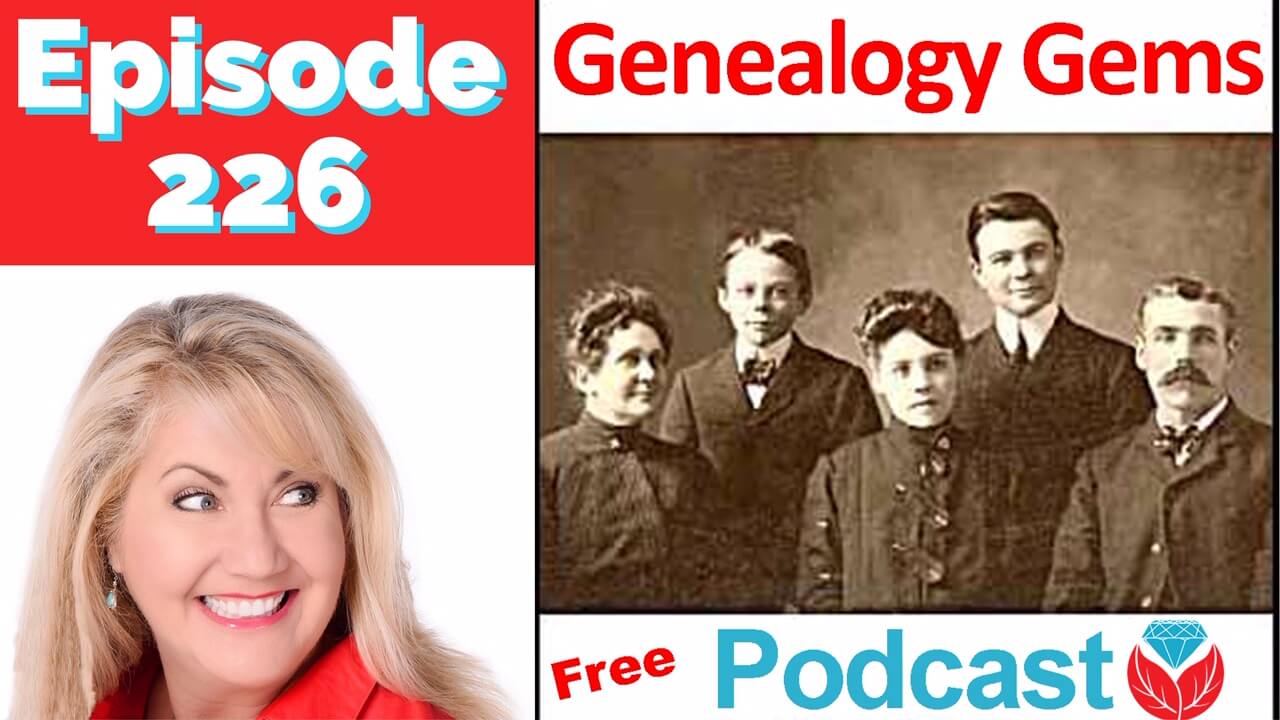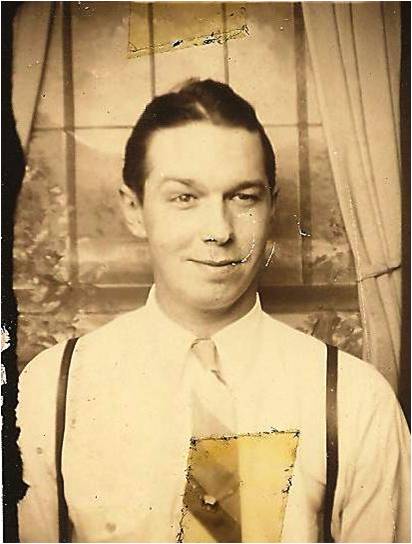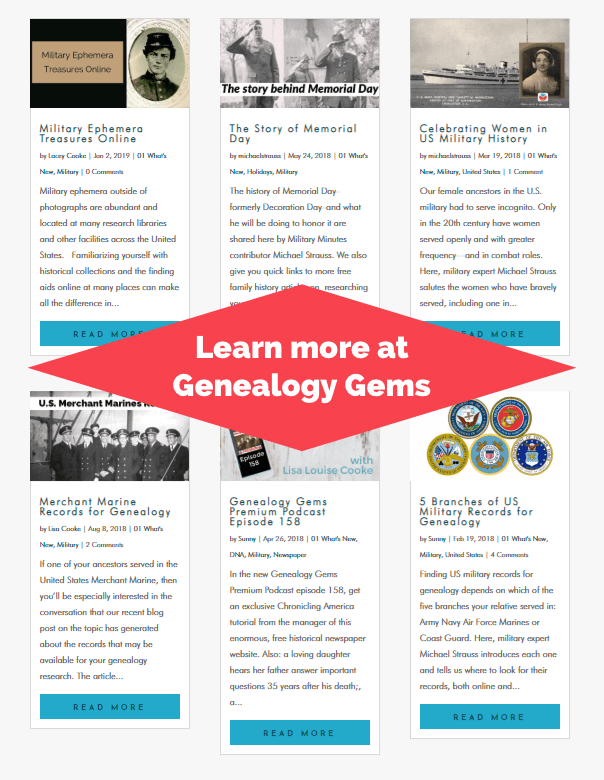Blog


New and Updated U.S. Genealogical Records Online
New U.S. records online for free this week! Explore military records from the Revolutionary War, the War of 1812, WWI, and WWII. Plus we’ve got a wide assortment of vital records, church records, county and criminal records, and more. You never know where your U.S. ancestors may be hiding, so take a look at these new and updated collections, noted by state.
Featured: New U.S. Records
FamilySearch.org has released lots of new collections for U.S. records that you will definitely want to explore.
Hawaii, Russian Immigrant Laborers Index 1909-1910: These records were probably recorded in Harbin, Manchuria in 1909 by A.L.C. Atkinson and A.W. Perelstrous. They were recruiting Russians to work on the Hawaii plantations. A.L.C. Atkinson was a Special Agent for the Territorial Board of Immigration.
Minnesota Birth and Death Records, 1900-1953: This collection contains an index and images to births and deaths recorded in Frankfort Township and St. Michael Village, Wright County, Minnesota, for the years 1900 to 1953. The birth records appear in both certificate and register-style documents. Some burial permits, are also included.
New Hampshire Obituaries, 1800-2007: The collection consists of cemetery records from the Pine Grove, Valley and other cemeteries in the Manchester area. The records provide the name and age of deceased, date of death, date of burial, birth date of deceased, location of grave, cause of death, and the name of undertaker.
Oregon, World War I, County Military Service Records, 1919-1920: This is a collection of WWI Military Service Records for various counties in the state of Oregon. The records are arranged alphabetically by county name, then numerical by the school district and alphabetical by surname. This series documents an individual’s military service in Oregon during WWI and used as a basis for medal distribution.
Oregon, Yamhill County Records, 1857-1963: This collection was recently updated, and includes images of deeds, mortgages, and military service records from Yamhill County. It also includes 6 volumes of “Miscellaneous Records” dated 1899-1957. The miscellaneous records include some land transactions, licensing records and other items.
Texas, Gonzales County, Death records, 1863-1970: The collection was recently updated with over 36,000 more records. It includes an index and browse-only images.
Utah Early Church Information File, 1830-1900: Browse images of index cards in alphabetical order for some members of the LDS Church. The names on the cards come primarily from sources from 1830 to the mid-1900s. The Early Church Information File (ECIF) was created using various sources including LDS church records, journals, biographies, cemetery records, immigration records and published books.
Rosters of Revolutionary War Soldiers and Sailors, 1775-1783: Look for your Revolutionary War ancestors in this collection of published state rosters of Revolutionary War soldiers from the states of Alabama, Connecticut, Massachusetts, New Jersey, Vermont, and Virginia.
More U.S. Collections
From the Digital Library of Georgia: Athens, Georgia crime dockets from 1902 to 1907 now freely available online. “The digital collection consists of eight bound dockets dating from 1902 to 1907, and includes about 5,760 individual arrest cases in Athens, Georgia. Entries generally include a case number, the defendant’s name, the code violated, the date and location of the arrest, the date papers were served, the arresting officer’s name, a list of witnesses, and the dispensation of the case.”
University of Arkansas: A Belated Gift: U.S. Copyright and the Public Domain. “The University Libraries launched a new digital exhibit in celebration of Public Domain Day Jan. 1. ‘A Belated Gift: U.S. Copyright and the Public Domain,’ which features Arkansan contributions from 1923 that are now in the public domain, is available to researchers worldwide, free of charge.”
War of 1812 Pension Files Update: Fold3 has almost completed digitizing through the letter “P” with their War of 1812 collection. The files are organized by state or organization, and then by the soldier’s surname and given name. While the digitization process is slow, they are continuing to add to this collection and will continue to do so until it is complete, so keep checking back!
From Findmypast: United States Directories & Almanacs
93 volumes of New York City Directories spanning the years 1786 to 1923 are now available to search. These new directories record the names and addresses of city residents, businesses, churches, schools, police stations, courts, and other government offices, as well as the names of individuals associated with those institutions. They also feature images, including maps, illustrations of buildings, and advertisements.
Hawaii News Now: Never-before-seen trove of photos shows Honolulu during height of World War II. Nearly 800 photos taken on Oahu during WWII have been discovered and digitized. Many of the photos feature military personnel, but few names are listed. The World War II Pacific Veterans Project was founded in an effort to identify these soldiers. In addition, these photos depict life on the island 70 years ago, which looks vastly different than it does today and gives context to soldier life during WWII.
Get tips on U.S. records research and more!
Are you listening to The Genealogy Gems Podcast yet? This free audio show helps you make the most of your family history research time by providing quick and easy-to-use research techniques. Producer and host Lisa Louise Cooke brings you the best websites, best practices, and best resources available. This podcast is 100% free!
Click here to start listening right now on our computer.
On your smartphone or tablet it’s as easy as 1-2-3:
- open your device’s podcast app: Apple Podcasts on the iPhone / iPad, or Google Podcasts on Android.
- search for “Genealogy Gems”.
- When the show pops up, tap the “Subscribe” button.
That way, the show will be in your podcast app’s Library ready to listen when you are!

Lacey Cooke
Lacey has been working with Genealogy Gems since the company’s inception in 2007. Now, as the full-time manager of Genealogy Gems, she creates the free weekly newsletter, writes blogs, coordinates live events, and collaborates on new product development. No stranger to working with dead people, Lacey holds a degree in Forensic Anthropology, and is passionate about criminal justice and investigative techniques. She is the proud dog mom of Renly the corgi.
Disclosure: This article contains affiliate links and Genealogy Gems will be compensated if you make a purchase after clicking on these links (at no additional cost to you). Thank you for supporting Genealogy Gems!

Episode 226: The Free Genealogy Gems Podcast
Episode 226
Welcome, my friend, to the podcast where we take joy in the discovery of your family’s history! In today’s show we’ll cover:
- research strategies and new resources
- the history of your ancestors’ baby clothing
- a tech tip that protects you
- and the key to deciphering draft registration cards
Download the Show Notes PDF in the Genealogy Gems Podcast app.
Download the episode (mp3)

GENEALOGY NEWS:
GEM: They Shall Not Grow Old
There are so many things I want to cover every month, but I try really hard to sift through it all and bring you the best of the best, the genealogy gems. And I LOVE when you bring me Gems! Just like Betty did recently.
Betty is taking my online course at Family Tree University this month called Google Earth for Genealogy which I told you about in our weekly newsletter. You’re all signed up for that right?
Well Betty was so excited about something she found that she wrote the following on our course discussion board.
She says: “My husband and I just saw the movie “They Shall Not Grow Old” about the soldiers in WWI. We saw it in 3-D, which was amazing! The whole movie is remastered, colorized video and audio from the newsreels and also the soldiers’ interviews in the 1960’s and 70’s. The director, Peter Jackson, introduces the movie and then, the best part is after the show.”
Watch the trailer:
I saw her message at about 8:00 that night, and I immediately grabbed Bill and jumped in the car and for the 9:30pm showing. I couldn’t agree more that it was spectacular.
From Betty: “When I read that you went straight to the movie, I almost cried I was so happy! I knew you would like the last 1/2 hour the best. When Peter Jackson talked about everyone finding out about the history of their family, I was so excited! Wasn’t it amazing what they could do with old video, still shots, cartoons, and audio interviews? It has so much potential for genealogists. The most important thing is to gather the information and digitize the videos we already have. In the future, maybe the technology will be more accessible to us, non-professional family historians. What a treasure that movie was! I hope it inspires more people to do the same with other aspects of WWI or other historical subjects.”
GEM: Baby Clothes
Valentine’s Day brings to mind visions of cupid, a baby dressed only in a nappy shooting arrows of love at unsuspecting couples. While this little cherub celebrates the holiday au natural, let’s take some time to talk about the fashion statements the babies in our family tree have made through the centuries. To help us visualize the togs those tots wore we could turn to our grandmother’s photo albums, but there we may find a surprise: lots of photos of female ancestors and surprisingly fewer of the males. Why is that? Allison DePrey Singleton, Librarian at the Allen County Public Library Genealogy Center unravels the mystery and stitches together a delightful history of baby clothing.
Sources:
Baumgarten, Linda. What clothes reveal: the language of clothing in colonial and federal America: the Colonial Williamsburg Collection. Williamsburg, VA: Colonial Williamsburg.
Calvert, Karin Lee Fishbeck. Children in the house: the material culture of early childhood, 1600-1900. Boston: Northeastern University Press, 1992.
F., José Blanco, Mary D. Doering, Patricia Hunt-Hurst, and Heather Vaughan Lee. Clothing and fashion: American fashion from head to toe. Vol. 1-3. Santa Barbara, CA: ABC-CLIO, an imprint of ABC-CLIO, LLC, 2016.
Hiner, N. Ray., and Joseph M. Hawes. Growing up in America: children in historical perspective. Urbana: University of Illinois Press, 1985.
Paoletti, Jo B. “Clothing and Gender in America: Children’s Fashions, 1890-1920.” Signs: Journal of Women in Culture and Society 13, no. 1 (1987): 136-43. doi:10.1086/494390.
Paoletti, Jo Barraclough. Pink and blue: telling the boys from the girls in America. Bloomington: Indiana University Press, 2012.
“When Did Girls Start Wearing Pink?” Smithsonian.com. Accessed January 10, 2017. http://www.smithsonianmag.com/arts-culture/when-did-girls-start-wearing-pink-1370097/.
MAILBOX:
Mary Lovell Swetnam, Special Collections Librarian Virginia Beach Public wrote me to tell us all about a new online resource. “I was able to determine that hundreds of records of enslaved persons were not included in either of the two previous abstracts of the Overwharton Parish Register. They have now been abstracted and are available free on our site.
Please see the link below. I have also included a copy of the explanatory material for the project. http://cdm16450.contentdm.oclc.org/cdm/compoundobject/collection/p16450coll15/id/14/rec/2.”
Dana wrote in with one purpose in mind: to share her genealogy happy dance with us. And I think that’s an awesome reason to write! Email or leave a voice mail at (925) 272-4021 and share your genealogy happy dance with me!
GEM: Scottish Genealogy
Amanda Epperson Ph.D. shares 3 strategies for finding an ancestor in Scottish records. Read the full article here.
Amanda Epperson is the author of the book The Family Tree Scottish Genealogy Guide. Since completing her Ph.D. in history from the University of Glasgow in 2003, Amanda has taught history at the college level, researched and edited family histories, most recently for Genealogists.com, and written articles for a variety of publications including Family Tree Magazine and Your Genealogy Today.
Become a Genealogy Gems Premium eLearning Member
Gain access to the complete Premium podcast archive of over 150 episodes and more than 50 video webinars, including Lisa Louise Cooke’s newest video The Big Picture in Little Details.
TECH GEM: Locate My Computer with Backblaze
Backblaze executive Yev Pusin explains a little-known feature that just might get you out of a jam! Learn more about Backblaze computer cloud backup and get your computer backed up today at www.backblaze.com/Lisa
GEM: Military Minutes – Draft Registration Cards Deciphered
We are revisiting Draft Registrations for both World War I and World War II. You will recall that this was the subject of our first “Military Minutes” together; since this aired several listeners have had questions and comments regarding the numbering on the cards, draft classifications, and how to dig deeper into other records of the Selective Service System whose office was responsible for the registering of all the men during both wars.
Click the images below to see all of the documents Michael discusses in this episode:
GEM: Profile America – America’s First Hospital
Monday, February 11th. Among his very many achievements, Benjamin Franklin played a leading role in the founding of America’s first hospital. Together with Dr. Thomas Bond, he obtained a charter for a hospital to serve the poor, sick and insane in Philadelphia. The Pennsylvania Hospital opened on this date in 1752 in a converted house.
Sources:
Joseph Nathan Kane, Kane’s Famous First Facts, Fifth Edition, H.W. Wilson Co., New York, NY 1997, 4868
Hospitals and employment, County Business Patterns, NAICS 622
Hospital revenue, Economic Census, NAICS 622
PRODUCTION CREDITS
Lisa Louise Cooke, Host and Producer
Bill Cooke, Audio Editor
Lacey Cooke, Your Happiness Manager
Disclosure: As an Amazon Associate, Genealogy Gems earns from qualifying purchases you make when clicking from the links we provide. It doesn’t cost you anything extra but it helps support our free blog and podcast. Thank you!

Deciphering Draft Registration Cards for Genealogy: World War II
Our Military Minutes Man Michael Strauss revisits the first subject he covered with us on the Genealogy Gems Podcast: Draft Registrations for both World War I and World War II. This is Part 2, covering WWII. Click here to read Part 1 for background about the numbering on the cards, draft classifications, and the Selective Service System. Then read on to learn all about WWII draft registration records.
Michael has the answers for us. Attention, March!
The World War II Draft:
On the eve of World War II, our country witnessed the passage of another national conscription act. It was called the Selective Training and Service Act of 1940 (54 Stat. 885). It turned out to be the first peacetime act in United States history. With a growing population for the United States, this meant that the draft process would be greatly expanded with more registrants.
All men regardless of citizenship status between the ages of 18 and 65 were registered in seven separate classification groups. Like the previous Selective Service Act of 1917 and the draft cards, these draft cards also recorded similar information on the upper left corner, which included the serial number, and the order number in the upper right corner, with nearly the same process being followed.
On October 29, 1940 Secretary of War Henry L. Stimson drew numbers from a bowl representing the first registration for men between 21-36.

Image courtesy of Library of Congress in Washington, DC showing Secretary of War Henry Stimson drawing the first number for Draft in 1940 for World War II
The first number drawn of the 7,836 serial numbers that were printed on paper and placed in individual capsules was No. 158. This number belonged to Harry Robert Bell, a 21-year-old from Washington D.C. (see image below). The hundreds of men across the United States pulled in this first drawing were all given an order number of 1.

Harry Robert Bell-WWII Draft Card-First Person Drafted
World War II Draft Registration Cards

Edgar L. Strauss (photo courtesy of Michael Strauss)
Genealogists can determine which of the seven draft registrations cards their ancestors filled out by noting the letters that were placed in front of the serial numbers for five of the seven registrations:
- 2nd registration is preceded by an “S”
- 3rd registration is preceded by a “T”
- 4th registration (or Old Man’s Draft) is preceded by a “U”
- 5th registration is preceded by an “N”
- 6th registration is preceded by a “W”
Only the 1st and 7th were not lettered before the numbering system.

Edgar L. Strauss-WWII Draft Card (image courtesy of Michael Strauss)
On the back of the card is stamped the local draft board number and location where the registrant went to fill out the form. These were cataloged nearly the same way as the previous war with the State, District Number, and local Board. The National Archives in College Park, MD has a master list of all the draft board numbers and locations alphabetically by state and territory.

Edgar L. Strauss-WWII Draft Card-Back (Image courtesy of Michael Strauss)
Contact the National Personnel Record Center in St. Louis, MO to obtain copies of the Draft Classifications for World War II and subsequent periods, and dockets to determine the status. During World War II, draft classifications were listed using first a “Roman Numeral and then a Letter” giving the status of each registrant.
Some of the more common Classifications included:
- I-A Fit for military service (could be inducted into service)
- II-B Deferred necessary to National Defense
- III-A Service deferred to hardship/Dependents
- III-B Occupation vital to War Effort
- IV-D Minister of religion
- IV-E Conscientious Objector
- IV-F Rejected For Military Service
Image above: WWII Draft Classification List including Edgar L Strauss – Order #1495. (Courtesy of Michael Strauss)
For a complete listing of all of the classifications for World War I through World War II and including post-war service for the Vietnam and Korean warm, contact the college at Swarthmore University in Pennsylvania. They have recorded each of the listings along with explanations. Once this is done, contact the Archives in College Park, MD to obtain other Selective Service records. All records are part of Records Group 147.
 Resources for Learning More About World War I and Military History
Resources for Learning More About World War I and Military History
Move backward in time from World War II to the Great War with Michael’s article Deciphering Draft Registration Cards for Genealogy: World War I.
Then, click the image on the right to head to our comprehensive collection of articles on military history.

Author: Michael Strauss, AG
Michael Strauss, AG is the principal owner of Genealogy Research Network and an Accredited Genealogist since 1995. He is a native of Pennsylvania and a resident of Utah and has been an avid genealogist for more than 30 years. Strauss holds a BA in History and is a United States Coast Guard veteran.











